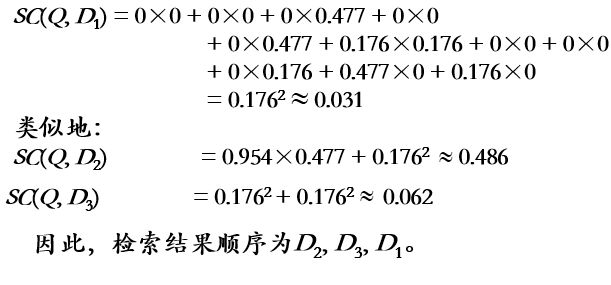【Python】向量空间模型:TF-IDF实例实现(set.union())
一、部分理论介绍
向量空间模型(VSM:Vector Space Model)
TF-IDF(term frequency–inverse document frequency)
TF是词频(Term Frequency),IDF是逆文本频率指数(Inverse Document Frequency)
其他理论部分请依据关键词自行探索研究。
二、TF-IDF相关实例
1、题目
Q:“gold silver truck”
D1:“Shipment of gold damaged in a fire”
D2:“Delivery of silver arrived in a silver truck”
D3:“Shipment of gold arrived in a truck”
基于TF-IDF向量化方法,求文档Q与文档D1、D2、D3相似程度。
2、分析过程
在这个文档集中,d=3。
lg(d/dfi) = lg(3/1) = 0.477
lg(d/dfi) = lg(3/2) = 0.176
lg(d/dfi) = lg(3/3) = 0

3、代码分享:
直接上完成代码:
import numpy as np
import pandas as pd
import math
#1.声明文档 分词 去重合并
D1 = 'Shipment of gold damaged in a fire'
D2 = 'Delivery of silver arrived in a silver truck'
D3 = 'Shipment of gold arrived in a truck'
split1 = D1.split(' ')
split2 = D2.split(' ')
split3 = D3.split(' ')
wordSet = set(split1).union(split2,split3) #通过set去重来构建词库
#2.统计词项tj在文档Di中出现的次数,也就是词频。
def computeTF(wordSet,split):
tf = dict.fromkeys(wordSet, 0)
for word in split:
tf[word] += 1
return tf
tf1 = computeTF(wordSet,split1)
tf2 = computeTF(wordSet,split2)
tf3 = computeTF(wordSet,split3)
print('tf1:\n',tf1)
#3.计算逆文档频率IDF
def computeIDF(tfList):
idfDict = dict.fromkeys(tfList[0],0) #词为key,初始值为0
N = len(tfList) #总文档数量
for tf in tfList: # 遍历字典中每一篇文章
for word, count in tf.items(): #遍历当前文章的每一个词
if count > 0 : #当前遍历的词语在当前遍历到的文章中出现
idfDict[word] += 1 #包含词项tj的文档的篇数df+1
for word, Ni in idfDict.items(): #利用公式将df替换为逆文档频率idf
idfDict[word] = math.log10(N/Ni) #N,Ni均不会为0
return idfDict #返回逆文档频率IDF字典
idfs = computeIDF([tf1, tf2, tf3])
print('idfs:\n',idfs)
#4.计算tf-idf(term frequency–inverse document frequency)
def computeTFIDF(tf, idfs): #tf词频,idf逆文档频率
tfidf = {}
for word, tfval in tf.items():
tfidf[word] = tfval * idfs[word]
return tfidf
tfidf1 = computeTFIDF(tf1, idfs)
tfidf2 = computeTFIDF(tf2, idfs)
tfidf3 = computeTFIDF(tf3, idfs)
tfidf = pd.DataFrame([tfidf1, tfidf2, tfidf3])
print(tfidf)
#5.查询与文档Q最相似的文章
q = 'gold silver truck' #查询文档Q
split_q = q.split(' ') #分词
tf_q = computeTF(wordSet,split_q) #计算Q的词频
tfidf_q = computeTFIDF(tf_q, idfs) #计算Q的tf_idf(构建向量)
ans = pd.DataFrame([tfidf1, tfidf2, tfidf3, tfidf_q])
print(ans)
#6.计算Q和文档Di的相似度(可以简单地定义为两个向量的内积)
print('Q和文档D1的相似度SC(Q, D1) :', (ans.loc[0,:]*ans.loc[3,:]).sum())
print('Q和文档D2的相似度SC(Q, D2) :', (ans.loc[1,:]*ans.loc[3,:]).sum())
print('Q和文档D3的相似度SC(Q, D3) :', (ans.loc[2,:]*ans.loc[3,:]).sum())
4、部分结果
文档1的词频:
逆文档频率idf:

tf-idf向量空间:

4篇文档组成的向量空间:

相似度SC:

三、部分参考资料
1、文本特征抽取的向量空间模型(VSM)和TF/IDF方法
2、06_TF-IDF算法代码示例
3、用20 newsgroups数据来进行NLP处理之文本分类
4、Python Set union() 方法


